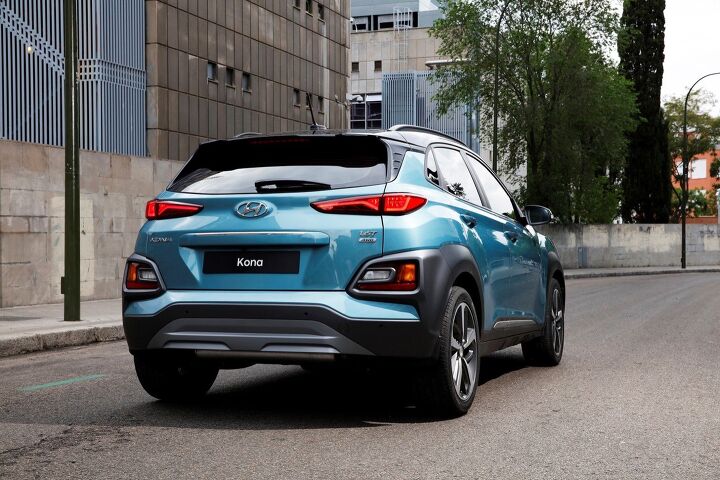Hyundai Releases Kona Pricing, Positions Subcompact Crossover As Value Leader

We’ll have to wait until Nissan releases pricing for its weirdly named Kicks before we can declare the 2018 Hyundai Kona the least-expensive subcompact crossover in America, but that’s the way it is for now.
The Korean automaker released its pricing list for the Kona on Wednesday, revealing a vehicle that undercuts every one its American and Japanese rivals in entry cost. Starting price for a Kona? $20,450 after delivery for a front-wheel-drive SE model.
That’s $195 cheaper than a base Honda HR-V, currently the best-selling subcompact crossover on the American market. The three-cylinder Ford EcoSport, which started sales in January, starts at $20,990 after delivery — a $540 difference. Compared to other competitors, the base Kona falls below the entry-level Mazda CX-3 by $635, the Chevrolet Trax by $1,545, and the Toyota C-HR by $3,045.
All of the crossovers listed are front-wheel-drive models powered by engines ranging from Ford’s 1.0-liter EcoBoost three-cylinder to the 2.0-liter units found in the Kona, C-HR, and CX-3.
The Kona’s Atkinson-cycle base engine, found on SE and SEL trims, makes 147 horsepower and 132 lb-ft of torque. A six-speed automatic is the engine’s only dance partner. Uplevel Limited and Ultimate trims gain a turbocharged 1.6-liter four-cylinder and seven-speed dual-clutch automatic, good for 175 hp and 195 lb-ft.
Adding all-wheel drive to a base SE brings the Kona’s after-delivery price to $21,750, just below that of a FWD Trax. (There’s incentives to be had on that model, though.) A better-equipped Kona SEL stickers for $22,100, or $23,400 is AWD is a must. If you can’t live with a vehicle unless its roof color contrasts with its body, throwing $150 at Hyundai nets you this feature on both SEL models.
Moving up the ladder, Limited models start at $25,650, with AWD variants rolling out the door for $26,950. Achieving the Ultimate means parting with $28,350, though going AWD adds another $1,300. This places the top-most Kona at just under the 30k mark— an important bar to stay below, considering the Kona’s place in the Hyundai food chain.
Shorter than a CX-3 and boasting 6.7 inches of ground clearance, the Kona arrives at U.S. dealers this spring. While the B-segment crossover market isn’t huge, Hyundai needs all the sales it can get. It also needs a presence in as many segments as possible.
After seeing a 14.3 percent drop in U.S. volume last year, Hyundai’s planning a crossover offensive over the next two years, with the Kona being the first out the gate.
[Image: Hyundai]

More by Steph Willems
Latest Car Reviews
Read moreLatest Product Reviews
Read moreRecent Comments
- KOKing Kinda hate to say this but they need to be an American Land Rover sans the offroad image (and capability). Leave the Escalade alone and do a shrunken Escalade-esque lineup (the first time I saw a Hyundai Palisade I thought that was the XT6 that Cadillac shoulda made) and dump the alphabet soup models and trims.
- Theflyersfan How to fix Cadillac? Blackwing.Now I know (because I've asked) dealers are still thinking they are selling Demons with the kinds of markups on Blackwings, but for enthusiast drivers in the know, those cars are legit. They get lost in the shuffle of M-this and AMG-that, but they hold their own. However, with rising CAFE standards and upcoming emissions requirements, along with European CO2 limits, they all can't be turbo V8s with no hybrid propulsion. So at least mild hybrid them to try to eke out another 8-10 mpg average. That's a good start. Do something with the Escalade. These aren't the early 2000s when they had the hip hop image and every corner had a jet black Escalade with chrome rims. In my area, you just don't see them any longer as money has moved to the Germans. If they want to compete with the Germans, they have to downsize it and crank the engine up to 11. It's still way too truckish to compete with the Q8, X7, and GLS. Even though they probably don't want to, keep the sedans. Don't give those up to the Germans, Japanese, and Koreans as well. And with all that, go all in with performance. Become what BMW was over 15 years ago. They tried that before and half assed it, but they have the tools to make it happen now. Try to appeal to the audience that BMW and Mercedes left behind and that Genesis and Acura are trying to claim (or reclaim). Good luck Cadillac...you'll need it.
- SCE to AUX Introduce a modern V-16 and put it into a Celestiq-like vehicle instead of electric.
- DungBeetle62 For where we're at in the product cycle, I think there are bigger changes afoot. With this generation debuting in 2018, and the Avalon gone, is the next ES to be Crown based? That'll be an interesting aesthetic leap.
- Philip Precht When Cadillac stopped building luxury cars, with luxury looks, that is when they started their downward spiral. Now, they just look like Chevrolet knock-offs, not much luxury, no luxurious looks. Interiors are just generic. Nothing what they used to look like. Why should someone spend $80,000 on a Cadillac when they can spend a LOT less and get a comparable looking Chevrolet????



































Comments
Join the conversation
I fail to see the value in this car when a base Forester is only 2k more and 18" longer. They get the same mpg.
Eagerly anticipating Sanjeev's Vellum Venom on this mess. (Mess being everything below the door-handle level)